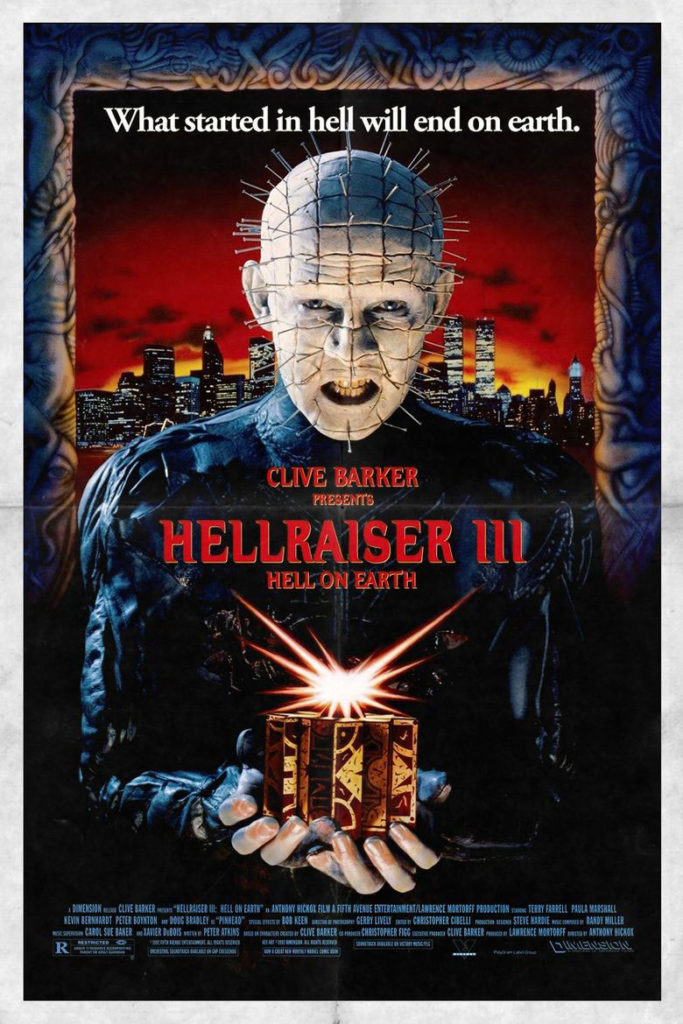Deciding to write about a particular movie has some unexpected difficulties (pardon me while I moan). I don’t get paid for writing about movies. I do this only because I feel like it. That is why there is little rhyme or reason when it comes to the reviews. I go where the mood takes me. But sometimes I get the urge to write a series of reviews, and make the decision to write a review before I watch a movie, rather than after. The distinction is important. If a film really grabs me, for whatever reason, I am more likely to write a review than not. But if a film is anonymous, leaving me troubling to recall what I saw mere hours after the credits rolled, then I probably will not bother with a review. How, then, to treat Hellraiser III: Hell on Earth? I decided to write this review as a follow-up to Hellraiser II, a film that was better than I expected. But this...
The movie neither moved nor outraged me. It was a Hellraiser movie, but that doesn’t mean it has any special cachet in film history. The first film in the franchise was a horror classic. It was far from perfect, but writer/director Clive Barker crafted a film worthy of preservation. All that has come after, even though the second film made a game effort, appears to exist to make a buck, and nothing more.
Directed by Anthony Hickox, from a screenplay by Peter Atkins and Tony Randel (the filmmaker responsible for Hellraiser II), Hellraiser III sends the story off in a new(ish) direction from the previous films. At the end of Hellraiser II, the evil Dr. Channard dispatched the four Cenobites, the demons of radical sexual pleasure who made the first film so unique. The most recognizable and popular of the four was,  of course, Pinhead (Doug Bradley). He has been imprisoned inside of a sculpture subsequently bought by scumbag nightclub owner JP Monroe (Kevin Bernhardt) as the centerpiece of his bachelor pad. The sculpture is accidentally splashed with some blood, and thus awakens Pinhead.
of course, Pinhead (Doug Bradley). He has been imprisoned inside of a sculpture subsequently bought by scumbag nightclub owner JP Monroe (Kevin Bernhardt) as the centerpiece of his bachelor pad. The sculpture is accidentally splashed with some blood, and thus awakens Pinhead.
Blood as a means to resurrection has become the plot device du jour in the Hellraiser series. This is only the third film and the technique smacks of grand laziness. But, that’s the way things are.
After his revival, Pinhead sets about killing nightclub patrons and building a new army of Cenobites, whereby he hopes to bring about hell on earth. There are other motivations and protagonists, and a plot element involving Pinhead being split into two distinct personalities, but all of this, while central to the story of the film, is peripheral to the idea of Pinhead. It is the Cenobites, and the character of Pinhead in particular, that is the strongest idea in the Hellraiser universe. When his character is poorly served, any film in which he appears suffers.
There were already signs in the preceding film that Pinhead was descending into caricature. He was marked by his stoicism in the first film. There were no lies or deceits. He was a master of pleasure and pain but his face betrayed no emotion other than fury. Yet even then, the rage never went beyond his eyes. In this third film Pinhead finds supreme joy in his role as villain. He smirks throughout, his ego grandiloquent and his speech matching in false profundities. He’s more Freddy Krueger than the Pinhead who appeared in the first film. For all his excesses, Pinhead requires that deep subtleties and mysteries remain, or all the audience gets is a disfigured clown.
The first film was brilliant because, despite the narrative power of the Cenobites, they were barely in the film. The story was about how badly human beings can mess things up, and the misguided actions they take to make the Cenobites appear. Keeping the story grounded in humanity makes the Cenobite angle all the more powerful. Hellraiser III is the first film in the series where fan service seems to be more important than all else. The result is an amateurish piece of garbage that cemented Hellraiser’s place alongside other wayward horror franchises such as Friday the 13th, Nightmare on Elm Street, Halloween, and even Jaws. At least we’ll always have the first film.
